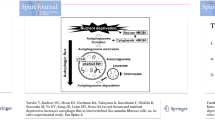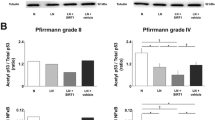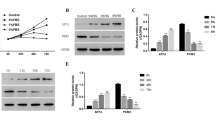Abstract
Excessive apoptosis of disc cells is believed to play an important role in intervertebral disc (IVD) degeneration. It has been shown that interleukin-1β (IL-1β) is involved in the failure of disc matrix by suppressing the synthesis of matrix components and stimulating the expression of matrix metalloproteinases. However, whether IL-1β induces disc cell apoptosis is still unclear. The objective of this study was to investigate the effect of IL-1β on the apoptosis of rat annular cells cultured with or without serum supplement. First-passage rat annular cells were cultured with 0% or 10% fetal bovine serum (FBS) supplement and stimulated with 0, 10, 20 or 50 ng/ml IL-1β for 12, 24 or 48 h. Apoptotic incidences were quantified by flow cytometry, morphologic changes in apoptotic cells were visualized by Hoechst 33258 staining and phase-contrast microscopy, and caspase-3 activity was also determined. When rat annular cells were cultured with 10% FBS supplement, no significant changes in apoptotic incidences, apoptotic morphology and caspase-3 activity were observed even when cells were stimulated with 50 ng/ml IL-1β for 48 h. In contrast, serum deprivation for 24 h led to an increase in apoptotic incidences, the number of apoptotic nuclei and caspase-3 activity, and IL-1β significantly increased the effects of serum deprivation in a dose-dependent manner. Our results indicate that IL-1β alone is not a sufficient stimulus to induce disc cell apoptosis and that in order to suppress disc cell apoptosis, improving the nutrient supply to the disc may be more effective than antagonizing the adverse effects of IL-1β.



Similar content being viewed by others
References
Waddell G (1996) Low back pain: a twentieth century health care enigma. Spine 21:2820–2825
Gruber HE, Hanley EN Jr (1998) Analysis of aging and degeneration of the human intervertebral disc: comparison of surgical specimens with normal controls. Spine 23:751–757
Lotz JC, Colliou OK, Chin JR, Duncan NA, Liebenberg E (1998) Compression-induced degeneration of the intervertebral disc: an in vivo mouse model and finite-element study. Spine 23:2493–2506
Ariga K, Miyamoto S, Nakase T et al (2001) The relationship between apoptosis of endplate chondrocytes and aging and degeneration of the intervertebral disc. Spine 26:2414–2420
Rannou F, Lee TS, Zhou RH et al (2004) Intervertebral disc degeneration: the role of the mitochondrial pathway in annulus fibrosus cell apoptosis induced by overload. Am J Pathol 164:915–924
Gruber HE, Norton HJ, Hanley EN Jr (2000) Anti-apoptotic effects of IGF-1 and PDGF on human intervertebral disc cells in vitro. Spine 25:2153–2157
Park JB, Park IC, Park SJ, Jin HO, Lee JK, Riew KD (2006) Anti-apoptotic effects of caspase inhibitors on rat intervertebral disc cells. J Bone Joint Surg Am 88:771–779
Wang YJ, Shi Q, Sun P et al (2006) Insulin-like growth factor-1 treatment prevents anti-Fas antibody-induced apoptosis in endplate chondrocytes. Spine 31:736–741
Lotz JC, Chin JR (2000) Intervertebral disc cell death is dependent on the magnitude and duration of spinal loading. Spine 25:1477–1483
Court C, Colliou OK, Chin JR, Liebenberg E, Bradford DS, Lotz JC (2001) The effect of static in vivo bending on the murine intervertebral disc. Spine J 1:239–245
Ariga K, Yonenobu K, Nakase T et al (2003) Mechanical stress-induced apoptosis of endplate chondrocytes in organ-cultured mouse intervertebral discs: an ex vivo study. Spine 28:1528–1533
Walsh AJ, Lotz JC (2004) Biological response of the intervertebral disc to dynamic loading. J Biomech 37:329–337
Kroeber M, Unglaub F, Guehring T et al (2005) Effects of controlled dynamic disc distraction on degenerated intervertebral discs: an in vivo study on the rabbit lumbar spine model. Spine 30:181–187
Risbud MV, Fertala J, Vresilovic EJ, Albert TJ, Shapiro IM (2005) Nucleus pulposus cells upregulate PI3K/Akt and MEK/ERK signaling pathways under hypoxic conditions and resist apoptosis induced by serum withdrawal. Spine 30:882–889
Kohyama K, Saura R, Doita M, Mizuno K (2000) Intervertebral disc cell apoptosis by nitric oxide: biological understanding of intervertebral disc degeneration. Kobe J Med Sci 46:283–295
Takahashi H, Suguro T, Okazima Y, Motegi M, Okada Y, Kakiuchi T (1996) Inflammatory cytokines in the herniated disc of the lumbar spine. Spine 21:218–224
Miyamoto H, Saura R, Harada T, Doita M, Mizuno K (2000) The role of cyclooxygenase-2 and inflammatory cytokines in pain induction of herniated lumbar intervertebral disc. Kobe J Med Sci 46:13–28
Le Maitre CL, Freemont AJ, Hoyland JA (2005) The role of interleukin-1 in the pathogenesis of human intervertebral disc degeneration. Arthritis Res Ther 7:R732–R745
Oda H, Matsuzaki H, Tokuhashi Y, Wakabayashi K, Uematsu Y, Iwahashi M (2004) Degeneration of intervertebral discs due to smoking: experimental assessment in a rat-smoking model. J Orthop Sci 9:135–141
Rannou F, Corvol MT, Hudry C et al (2000) Sensitivity of anulus fibrosus cells to interleukin-1β: comparison with articular chondrocytes. Spine 25:17–23
Kang JD, Stefanovic-Racic M, McIntyre LA, Georgescu HI, Evans CH (1997) Toward a biochemical understanding of human intervertebral disc degeneration and herniation: contributions of nitric oxide, interleukins, prostaglandin E2, and matrix metalloproteinases. Spine 22:1065–1073
Elfervig MK, Minchew JT, Francke E, Tsuzaki M, Banes AJ (2001) IL-1β sensitizes intervertebral disc annulus cells to fluid-induced shear stress. J Cell Biochem 82:290–298
Oliver BL, Cronin CG, Zhang-Benoit Y, Goldring MB, Tanzer ML (2005) Divergent stress responses to IL-1β, nitric oxide, and tunicamycin by chondrocytes. J Cell Physiol 204:45–50
Lopez-Armada MJ, Carames B, Martin MA et al (2006) Mitochondrial activity is modulated by TNF-α and IL-1β in normal human chondrocyte cells. Osteoarthr Cartil 14:1011–1022
Lopez-Armada MJ, Carames B, Lires-Dean M et al (2006) Cytokines, tumor necrosis factor-α and interleukin-1β, differentially regulate apoptosis in osteoarthritis cultured human chondrocytes. Osteoarthr Cartil 14:660–669
Heraud F, Heraud A, Harmand MF (2000) Apoptosis in normal and osteoarthritic human articular cartilage. Ann Rheum Dis 59:959–965
Yasuhara R, Miyamoto Y, Akaike T et al (2005) Interleukin-1β induces death in chondrocyte-like ATDC5 cells through mitochondrial dysfunction and energy depletion in a reactive nitrogen and oxygen species-dependent manner. Biochem J 389:315–323
Shakibaei M, Schulze-Tanzil G, John T, Mobasheri A (2005) Curcumin protects human chondrocytes from IL-1β-induced inhibition of collagen type II and β1-integrin expression and activation of caspase-3: an immunomorphological study. Ann Anat 187:487–497
Moskowitz RW, Ziv I, Denko CW, Boja B, Jones PK, Adler JH (1990) Spondylosis in sand rats: a model of intervertebral disc degeneration and hyperostosis. J Orthop Res 8:401–411
Aguiar DJ, Johnson SL, Oegema TR (1999) Notochordal cells interact with nucleus pulposus cells: regulation of proteoglycan synthesis. Exp Cell Res 246:129–137
Fernandez-Segura E, Canizares FJ, Cubero MA, Warley A, Campos A (1999) Changes in elemental content during apoptotic cell death studied by electron probe X-ray microanalysis. Exp Cell Res 253:454–462
Augstein P, Bahr J, Wachlin G et al (2004) Cytokines activate caspase-3 in insulinoma cells of diabetes-prone NOD mice directly and via upregulation of Fas. J Autoimmun 23:301–309
Nilkaeo A, Bhuvanath S (2006) Interleukin-1 modulation of human placental trophoblast proliferation. Mediators Inflamm 2006:79359
Gao Y, Camacho LH, Mehta K (2007) Retinoic acid-induced CD38 antigen promotes leukemia cells attachment and interferon-γ/interleukin-1β-dependent apoptosis of endothelial cells: implications in the etiology of retinoic acid syndrome. Leuk Res 31:455–463
Parrizas M, Saltiel AR, LeRoith D (1997) Insulin-like growth factor 1 inhibits apoptosis using the phosphatidylinositol 3′-kinase and mitogen-activated protein kinase pathways. J Biol Chem 272:154–161
Navarro P, Valverde AM, Benito M, Lorenzo M (1998) Insulin/IGF-I rescues immortalized brown adipocytes from apoptosis down-regulating Bcl-xS expression, in a PI 3-kinase- and map kinase-dependent manner. Exp Cell Res 243:213–221
Wang L, Ma W, Markovich R, Chen JW, Wang PH (1998) Regulation of cardiomyocyte apoptotic signaling by insulin-like growth factor I. Circ Res 83:516–522
Bai H, Pollman MJ, Inishi Y, Gibbons GH (1999) Regulation of vascular smooth muscle cell apoptosis. Modulation of bad by a phosphatidylinositol 3-kinase-dependent pathway. Circ Res 85:229–237
Ryu BR, Ko HW, Jou I, Noh JS, Gwag BJ (1999) Phosphatidylinositol 3-kinase-mediated regulation of neuronal apoptosis and necrosis by insulin and IGF-I. J Neurobiol 39:536–546
Barber AJ, Nakamura M, Wolpert EB et al (2001) Insulin rescues retinal neurons from apoptosis by a phosphatidylinositol 3-kinase/Akt-mediated mechanism that reduces the activation of caspase-3. J Biol Chem 276:32814–32821
Fernandez M, Sanchez-Franco F, Palacios N, Sanchez I, Fernandez C, Cacicedo L (2004) IGF-I inhibits apoptosis through the activation of the phosphatidylinositol 3-kinase/Akt pathway in pituitary cells. J Mol Endocrinol 33:155–163
Martensson K, Chrysis D, Savendahl L (2004) Interleukin-1β and TNF-α act in synergy to inhibit longitudinal growth in fetal rat metatarsal bones. J Bone Miner Res 19:1805–1812
Giannoukakis N, Mi Z, Rudert WA, Gambotto A, Trucco M, Robbins P (2000) Prevention of beta cell dysfunction and apoptosis activation in human islets by adenoviral gene transfer of the insulin-like growth factor I. Gene Ther 7:2015–2022
Harrison M, Dunger AM, Berg S et al (1998) Growth factor protection against cytokine-induced apoptosis in neonatal rat islets of Langerhans: role of Fas. FEBS Lett 435:207–210
Trout JJ, Buckwalter JA, Moore KC (1982) Ultrastructure of the human intervertebral disc: II. Cells of the nucleus pulposus. Anat Rec 204:307–314
Boos N, Weissbach S, Rohrbach H, Weiler C, Spratt KF, Nerlich AG (2002) Classification of age-related changes in lumbar intervertebral discs. Spine 27:2631–2644
Roberts S, Urban JP, Evans H, Eisenstein SM (1996) Transport properties of the human cartilage endplate in relation to its composition and calcification. Spine 21:415–420
Le Maitre CL, Freemont AJ, Hoyland JA (2006) A preliminary in vitro study into the use of IL-1Ra gene therapy for the inhibition of intervertebral disc degeneration. Int J Exp Pathol 87:17–28
Acknowledgement
This work was supported by the National Natural Science Foundation of China (No. 30700851).
Author information
Authors and Affiliations
Corresponding author
Rights and permissions
About this article
Cite this article
Zhao, CQ., Liu, D., Li, H. et al. Interleukin-1β enhances the effect of serum deprivation on rat annular cell apoptosis. Apoptosis 12, 2155–2161 (2007). https://doi.org/10.1007/s10495-007-0137-x
Published:
Issue Date:
DOI: https://doi.org/10.1007/s10495-007-0137-x




